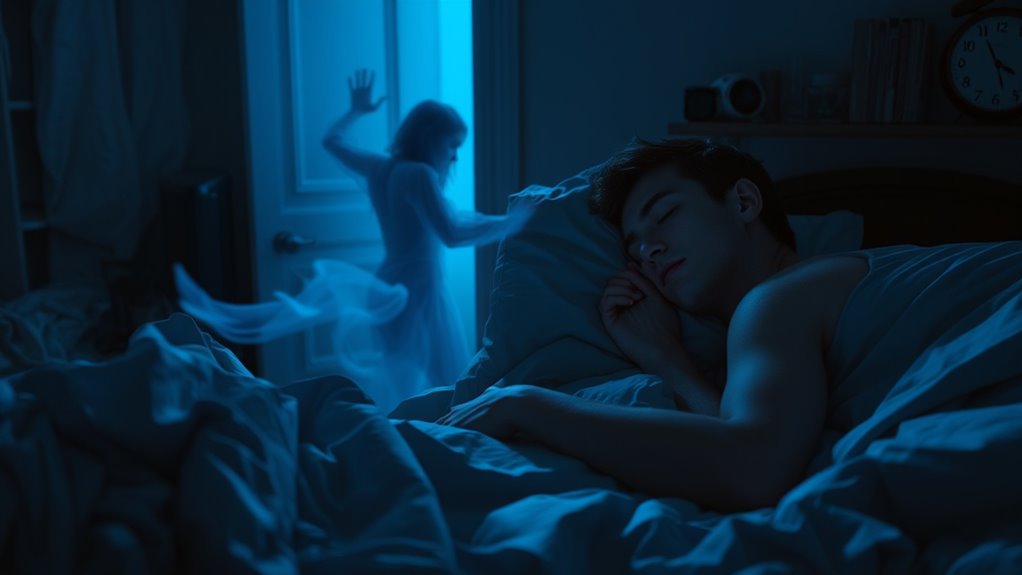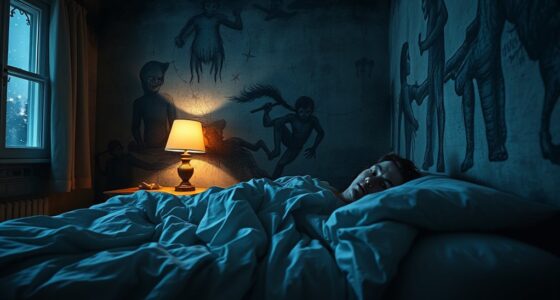If you have narcolepsy or sleep paralysis, your dreams might feel more vivid, emotional, or unsettling. Narcolepsy causes sudden sleep episodes that quickly lead into intense REM dreams, often blending into waking life. Sleep paralysis involves waking up unable to move, often with terrifying hallucinations resembling nightmares. These disorders disrupt normal sleep patterns and heighten your dream experiences. To understand how these issues influence your dream life and safety, keep exploring the details behind these sleep conditions.
Key Takeaways
- Narcolepsy causes vivid, emotional dreams due to rapid REM sleep onset and disrupted sleep patterns.
- Sleep paralysis involves inability to move with vivid hallucinations, often linked to disrupted REM sleep stages.
- Both narcolepsy and sleep paralysis can lead to dreams blending into waking life, causing confusion and distress.
- Narcolepsy-related REM abnormalities can induce hallucinations and intense dream experiences during sleep transitions.
- Sleep disorders like narcolepsy and paralysis significantly impact dream vividness, emotional content, and sleep safety.

Have you ever wondered how sleep disorders affect your dreams? If so, you’re not alone. Sleep issues can considerably alter the way you experience dreams, from vivid, controlled scenarios to frightening episodes. One interesting phenomenon linked to certain sleep disorders is lucid dreaming, where you become aware that you’re dreaming and can sometimes even control what happens. This often occurs during REM sleep, the stage where most dreaming occurs. However, some sleep disorders interfere with REM sleep in ways that make lucid dreaming more common or more intense. For example, individuals with REM sleep behavior disorder (RBD) often act out their dreams, sometimes violently. Normally, during REM sleep, your muscles are paralyzed, preventing you from physically acting out dreams. But in RBD, this paralysis is absent, leading to physical movements that can be startling or dangerous. This disorder can cause vivid, sometimes frightening dreams, as the boundary between dreaming and physical action blurs. This disruption may also lead to more vivid dreams, as the normal paralysis that suppresses physical activity during REM sleep is compromised. Consequently, your dream experiences might be more intense and memorable, but also more disruptive or harmful.
Lucid dreaming is fascinating because it offers a level of awareness and control that most people don’t experience in their dreams. For some, sleep disorders like RBD might increase the frequency or intensity of lucid dreams because the brain remains more active during certain phases of sleep. Conversely, other disorders, such as narcolepsy, can lead to sudden sleep episodes where dreams become more vivid and emotional. Narcolepsy disrupts normal sleep patterns, causing you to enter REM sleep suddenly during the day, which can lead to intense dream experiences that feel incredibly real. These dreams might blend seamlessly into waking life, sometimes causing confusion or hallucinations.
The connection between sleep disorders and dreaming isn’t just about vividness; it also involves the quality and safety of your sleep. For example, with REM sleep behavior disorder, acting out dreams can cause injuries or disturb your sleep cycle, making restful sleep elusive. Likewise, in cases of sleep paralysis, you might find yourself unable to move at the onset or end of sleep, often accompanied by vivid hallucinations that feel like nightmares. These experiences can be frightening but are tied directly to how your sleep architecture is disrupted. Overall, sleep disorders can profoundly influence your dreaming, either by intensifying dream experiences or by causing dangerous behaviors during sleep. Understanding these connections helps you better grasp how your sleep health impacts your dreams and overall well-being.
Frequently Asked Questions
Can Sleep Disorders Be Inherited Genetically?
Yes, sleep disorders can be inherited genetically. You might have a genetic predisposition or hereditary factors that increase your risk of developing conditions like narcolepsy or sleep paralysis. While genetics play a significant role, environmental influences also impact whether these disorders manifest. If someone in your family has a sleep disorder, you’re more likely to experience similar issues, but lifestyle choices and other factors can influence your overall risk.
How Do Dreams Differ During REM and Non-Rem Sleep?
Imagine you’re dreaming about flying during REM sleep, where your dreaming patterns are vivid and story-like. During REM, dreams are intense, emotional, and often memorable, reflecting active brain regions. In contrast, during non-REM sleep, dreams are usually dull, fragmented, or absent, with less vivid dreaming patterns. These differences arise from distinct sleep cycle stages, with REM dominating vivid dreaming and non-REM featuring lighter, less complex dreams.
Are There Natural Remedies for Narcolepsy?
You might find some relief from narcolepsy symptoms with natural remedies like herbal supplements and dietary adjustments. Incorporate herbs such as ginseng or valerian root, which can boost alertness and improve sleep quality. Additionally, maintaining a consistent sleep schedule and avoiding caffeine or heavy meals before bed can help regulate your sleep patterns. While these methods may support your overall health, consult a healthcare professional for personalized advice.
What Is the Long-Term Impact of Sleep Paralysis?
Sleep paralysis can cast a shadow over your life, affecting you long-term like a lingering fog. You might experience psychological effects such as anxiety or fear, and social implications like withdrawal from friends or activities. Over time, these impacts can chip away at your mental health and social well-being. Recognizing and managing sleep paralysis early helps reduce its long-lasting effects, allowing you to regain control and find restful nights again.
Can Sleep Disorders Be Prevented With Lifestyle Changes?
Yes, you can reduce your risk of sleep disorders by improving your lifestyle. Focus on sleep hygiene by maintaining a consistent sleep schedule, creating a relaxing bedtime routine, and avoiding screens before bed. Incorporate stress management techniques like meditation or exercise to lower stress levels, which can disrupt sleep. These habits help promote better sleep quality, making it less likely you’ll develop sleep disorders over time.
Conclusion
Understanding sleep disorders like narcolepsy and sleep paralysis reveals a world where dreams and reality collide. While you might long for restful nights, these conditions trap you in fleeting moments of consciousness and vivid nightmares. Yet, within these struggles lies hope for treatment and awareness. Remember, even in the darkness of disrupted sleep, your resilience shines through—reminding you that dreams, like life, can be navigated with courage and care.









